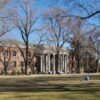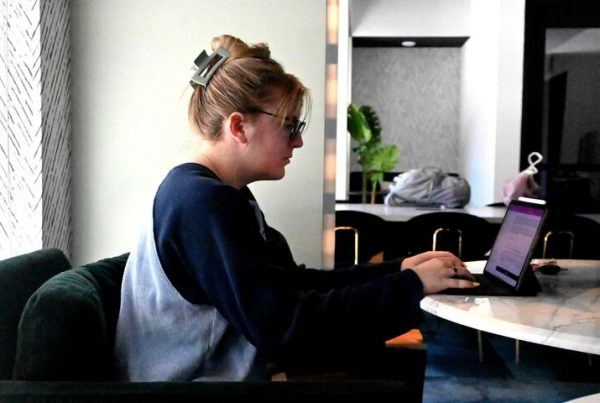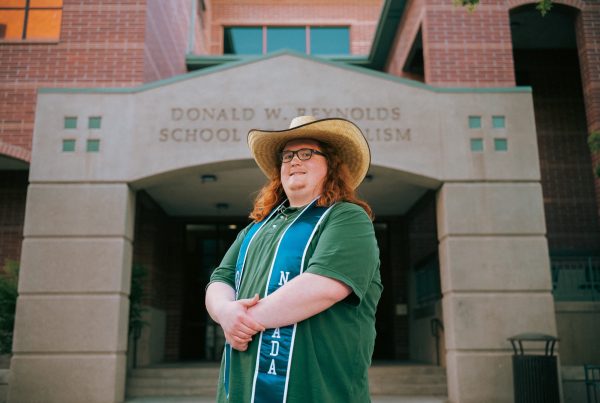
Liesel Kemmelmeier (right) and Isabella Valdivieso (left) answer questions in the ASUN vice presidential debates on March 12.
The Associated Students of the University of Nevada, Reno has a rapidly approaching election underway with general voting beginning on March 13 and continuing through March 14.
Currently, the two campaigns competing include YOURNevada, with presidential candidate Fayza Salah and vice presidential candidate Isabella Valdivieso versus Impact Nevada, with presidential candidate Dawson Deal and vice presidential candidate Liesel Kemmelmeier.
The vice presidential debates between Valdivieso and Kemmelmeier occurred earlier this evening for an hour.
Opening statements
Kemmelmeier won the coin toss and was granted the starting opening statement.
Kemmelmeier discussed that her campaign’s goal is to bring groups that are consistently overlooked together and make sure they feel welcomed.
“It is very clear to me that there’s a massive gap between students and the student body,” Kemmelmeier said. “They don’t feel represented in ASUN, they don’t even want to vote in the ASUN elections.”
Kemmelmeier also said that making sure students have professional development opportunities and career options when they are in attendance at the university is another priority for them. She added that there has always been communications issues between students and ASUN, so direct outreach with students is needed.
Valdivieso’s campaign centers around creating an empowering environment for students which focuses on and celebrates individual experiences. She added that they are committed to building campus communities for diversity.
“Our campaign focuses on the emphasis on the need for representation,” Valdiviseo said. “How can students feel safe and supported by our association without leaders who resemble them or understand their challenges?”
She also wanted to emphasize the need for student representation and making students feel safe and continue promoting equity and inclusivity.
Unfortunately, Valdivieso’s statement was cut off since her allotted time to speak was finished.
Question 1: In what ways do you plan to collaborate with student organizations and clubs to enhance campus engagement and foster a sense of community among students here at the University of Nevada Reno?
During open discussion, Kemmelmeier and Valdivieso agreed that ASUN should proactively communicate with clubs and organizations.
To combat the issue of poor communication between ASUN and organizations under its jurisdiction, Valdivieso suggests finding new avenues for communication.
“I think a big thing that comes with that is focusing on what we know already,” Valdivieso said.
“And how can we bridge that gap of re-emphasizing ASUN and that every single student on this campus is part of ASUN.”
Kemmelmeier discussed the results of the student survey the Department on Government Affairs put together last semester regarding needs amongst the students and how that was a direct communication with students on what they want to see improvement in. Kemmelmeier noted that ASUN places the burden of communication on student organizations, but she argues ASUN should be responsible for proactive communication.
Kemmelmeier argues ASUN’s struggle to communicate with the student body stems from the underdeveloped public relations department. The department currently consists of a single staff member, and Kemmelmeier states that putting the burden on a single person makes it difficult for ASUN to foster relationships with organizations it administers.
Question 2: As student body vice president, how do you plan to work to improve communication between the student body and university administration, ensuring the student concerns and feedback are effectively heard and addressed?
Valdivieso suggests greater transparency between the student government and the population it serves by becoming actively involved in discussions. Valdivieso presented the possibility of a bimonthly or monthly form of communication on administrative affairs. She also aims to make it possible for students to ask questions and to respond to concerns.
Kemmelmeier also intends to make ASUN an active party in discussions. She noted that some students do not know what ASUN is. Kemmelmeier emphasized accountability, transparency and collaboration for the faculty senate. She proposed the appointment of a liaison to each of the faculty senate committees. The new position would allow students to support faculty needs, but student interests are still of utmost importance.
Valdivieso wants to meet with students to inform them about happenings in the senate, executive and other branches of the student government. She argued students should be part of the conversation of ASUN innerworkings.
Kemmelmeier also mentioned the Nevada open meeting law and her desire to make information accessible online. The initiative would promote transparency through online tools such as a legislative tracker to monitor the progress of bills.
Question 3: The University of Nevada Reno is committed to sustainability and environmental stewardship. How do you intend to promote sustainability initiatives on campus and encourage environmentally friendly practices among students and faculty?
Valdivieso claimed that Nevada, as itself, is not set up to be sustainable and helpful to the student body. In many areas, there’s no support in these occasional student body and environment areas. She hopes to spur momentum by advancing existing initiatives for sustainability, safety and wellness. Valdivieso, in line with campaign messaging, wants to include students in discussions about how students want to see the campus practice sustainability.
Kemmelmeier notes the room for improvement in sustainability.
“I definitely think there’s big room for improvement on campus,” Kemmelmeier said. “I think in some cases though, we do have raised sustainability structures here on campus.”
Kemmelmeier acknowledged the university’s attempts to be sustainable. The DRI promotes sustainable farming practices. The university offers internship programs for sustainability practices. Recently, the Lake Tahoe campus began offering a certificate for sustainability to students, which Kemmelmeier wants to promote more. She also brought up fostering a deeper connection with the iServe initiative.
Valdivieso agreed with wanting to issue a deeper connection with the iServe initiative and added that she wanted to involve students interested in sustainability in the discussion more thoroughly.
Kemmelmeier recognizes the recreation clubs focused on sustainability but would like to improve community advocacy. She suggested working on the city level, such as with the city council, to mirror sustainability initiatives from Downtown Reno and Midtown.
Question 4: Mental health and wellness are essential aspects of student success. What strategies will you implement to enhance mental health resources and support services for students at the University of Nevada, and how will you destigmatize seeking help for mental health?
During open discussions, Kemmelmeier mentioned filling positions in the counseling department. She noted the difficulty students have in securing an appointment with counseling service and how it limits the program’s reach.
If it is not possible to make services accessible on campus, Kemmelmeier is open to making mental health services available in the Reno-Sparks area. She would like to find ways to counteract the issue through student outreach. She also added an emphasis on the importance of things like the new Annex Outreach Center for drop-in mental health support
Valdivieso wants to focus on making counseling centers available on campus, but she also acknowledged the lack of funds to make such an expansion. She still wants to continue to connect with students on how they want counseling centers to look and what services UNR’s center should provide.
Valdivieso would also like to work on destigmatizing mental health amongst different communities.
Audience Questions:
In your experience, what are the challenges faced by members of historical or historically underrepresented groups here and what strategies will you implement in your administration to address these challenges?
Valdivieso said a big part of it is understanding the financial burdens for unserved communities. She said finding ways for them to get access to that, including the Passion Fund. The addition she wants to add to this is being able to give money to students that have to pay for heavy testing score fees, including things like the LSAT. She thinks this will be a financial relief for struggling students.
She said a lot of conversations circle around how the university can get money which can benefit underserved communities, but she wants to make sure those students are getting the support they need.
Kemmelmeier said the financial barriers are tough for many communities and affordability is a main goal for their campaign. She adds that helping first generation students get access to the resources they need is essential.
She added that some of the funding was cut from undergraduate research, so she wants to prioritize that and prioritizing postgraduate fee waivers for post-grad research or schools.
Kemmelmeier also said that with the student fee increase, it will affect some more than others and she wants to be able to continue to provide resources to these groups and support them by promoting things like Pack Provisions and Pack Rides.
“Even if it only affects one student, it’s super important that we help students,” Kemmelmeier said.
Valdivieso added that as an out-of-state student, the tuition increase also affects her more greatly and so helping their university leaders that it affects every student differently is important.
How do you plan to connect students to ASUN?
Kemmelmeier believes the vice president’s role is centered around the community. She believes it would be her duty to promote the resources students fund with their tuition. She notes that juniors and seniors are wary of ASUN, and she hopes to gain trust through consistent communication.
She added that campaigning doesn’t stop when you get the role. “It’s honestly an obligation when you represent 17,000 students here on campus and I think it’s really important that you earn their trust through showing that you care,” Kemmelmeier said.
Valdivieso agreed with Kemmelmeier saying that a big part of it is showing students during things like orientation what ASUN is and what it does, and showing students that they are a part of the conversation.
During open discussion, Kemmelmeier acknowledged that it is not plausible to reach out to every club, but it is important to ensure that commissioners are actively reaching out to organizations.
Kemmelmeier wants to combine resources for events and seeks to uplift groups and believes ASUN is obligated to ensure students are aware of how clubs work — from how to start one or join an on-campus organization. For instance, Kemmelmeier noticed that ASUN does not provide a list of which coalition each club commissioner belongs to.
Valdivieso believes ASUN should ensure assistance to clubs by being more prepared to understand and respond to inquiries. She hopes to continue growth and improve visibility within the clubs and organizations division.
Kemmelmeier also noted that the Department of IDEA does not receive sufficient financial resources — despite ASUN’s praises for IDEA’s initiatives.
What makes you a better candidate than the other?
“I feel like saying over-qualified feels disrespectful from one person to another,” Valdivieso said.
Valdivieso then discussed how her existence in student government is not a position grab, but instead a passion to open a space up to people if they’re interested. She also added that she uses her life experience as a strong woman of color to bring them to the table and she just wants to continue understanding what the students want from their campus community.
Kemmelmeier asserted that her focus is on student recruitment, retention and community comfort. She aims to strengthen ASUN’s relations to other organizations on campus. She also wants to reach out to Nevada Athletics to bridge the gap between sports and ASUN.
Kemmelmeier wants to work towards a Pack-friendly business program by establishing connections with local businesses for support and student discounts.
Valdivieso added that a vice president’s primary goal is to increase student engagement and focus on obtaining resources that will best support the student body. She said experience with student services and having the passion for it will help with this to increase community outreach.
Kemmelmeier told the audience that Salah asked her to be her running mate in October, when they discussed topics like this.
Kemmelmeier added she wants to keep supporting student workers and supporting student media in funding and other resources, if the organizations aren’t funded by the ballot question. She wants to continue working with student media to look for other outlets to help with funding if the question is not passed, so students can continue to share their voices and have that creative outlet.
Closing statements:
In her final remarks, Valdivieso highlighted the main points of her campaign.
“A lot of our commitment is with breaking the status quo,” Valdivieso said. “How do we move forward? How do we fit in the spaces of moving in different directions? How do we build upon good things that have happened? And how do we move forward to make them better?”
Valdivieso said this could be dismantling institutional barriers, redefining power structures and serving student needs. She said they aim to create a campus culture that unites everyone, highlight each individual student experience and help them find their home away from home.
In Kemmelmeier’s final remarks, she discussed the importance of bringing as many student experiences to the table as much as possible.
She said she doesn’t think they should put this pressure on the students, but instead invites them to collaborate with the student government.
Kemmelmeier said a lot of things remain unchanged in ASUN and that it’s important to work with students.
“I’m here to stay in Reno. I’m not going to law school, I was never involved with student government,” Kemmelmeier said, seemingly undercutting Valdivieso who discussed her plan to go to law school in the future. “This has been one of the most amazing experiences I’ve had … at the same time I do see that students have a big mistrust in ASUN and I think its on us to be able to deserve their trust.”
She added they need to serve the needs of all students and said she is excited to see more student’s input and criticisms to build an ASUN students can trust.
Jaedyn Young, Nick Stewart and Jessie Cabrera can be reached at jaedynyoung@sagebrush.unr.edu or on Twitter @NevadaSagebrush.
Correction 3/12, 11:22 p.m.: Kemmelmeier brought up iServe initiative originally and it was not a mistake, she was asked to be Salah’s running mate in October. Kemmelmeier also brought up the initiative of the legislation tracker for transparency.
Correction 3/13, 10:30 a.m.: “For instance, Kemmelmeier noticed that ASUN does not provide a list of which coalition each club commissioner belongs to.”









